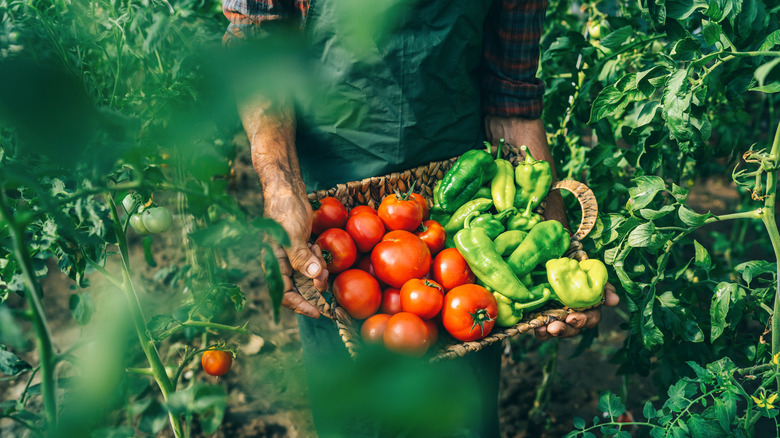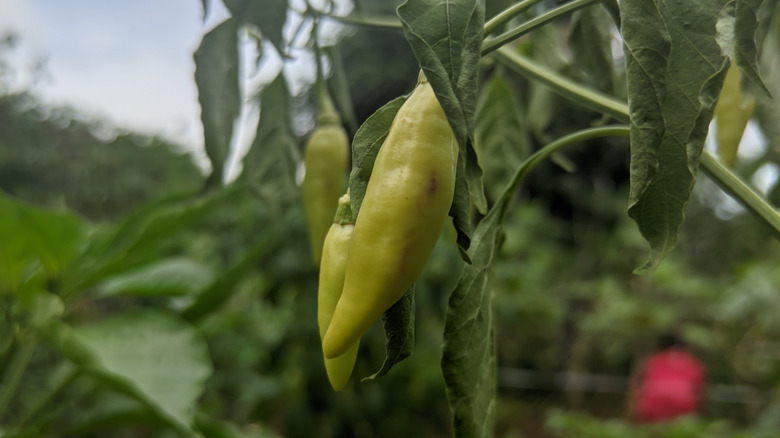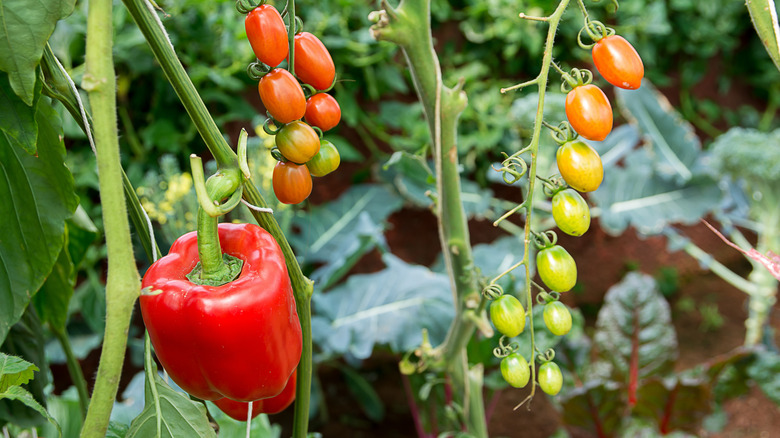Risks You Should Consider Before Planting Garden Tomatoes And Peppers Together
Anyone who's wanted to make their own homemade salsa knows fresh tomatoes and peppers are some of the most important ingredients. Since they blend so well in recipes, it might be tempting to grow the vegetables side-by-side in your garden. Before you do, however, consider the risks of planting tomatoes and peppers close to one another, and weigh the pros and cons.
Tomato plants and peppers are both members of the nightshade family, so they require similar growing conditions, like lots of sun and a soil pH between 6 and 8. Both are summer annual vegetables and will tolerate a wide swath of USDA Plant Hardiness zones from about 2 through 10. In zones of milder winters, such as zones 9 and 10, peppers might even behave like perennials, but it's a good idea to replant every year anyway to ensure a bumper crop of peppers every season.
Since tomatoes and peppers play so nicely together, why try to keep them apart? For starters, there's a risk when you plant two nutrient-hungry veggies together, as they might compete for the same resources. There's a more significant risk too. Because these plants are so similar, they can attract and fall prey to similar infections and diseases. Let's dig into these risks of planting tomatoes and peppers together and then talk about some of the ways to mitigate them.
Peppers and tomatoes share similar diseases and pests
Because peppers and tomatoes belong to the same Solanaceae plant family, they're susceptible to similar diseases. Tomatoes and peppers have a common weakness in blight, caused by the Phytophthora capsici fungus. Also referred to as root rot, this infection can lead to a wilting of the plants, and then eventually the browning of their leaves and the death of the plant.
Bacterial spot is another disease common to both plants, and it can affect every part of the plant above ground. It'll first appear as water spots (darker green spots on leaves or vegetables), often after a windy rainstorm. Bacterial spot evolves into brown sores that eventually can yellow or destroy entire leaves. Water spreads the bacteria, especially overhead watering. Avoid using sprinklers on these plants and water at soil level.
Bacterial and fungal infections aren't the only problems these vegetables face, either. They also share the same kinds of pests, including cutworms, aphids, whiteflies, and many others. If you want to know what eats the leaves and tomatoes on plants, the answer is: many kinds of bugs! Slugs and snails, as well as flea beetles, potato beetles, and grasshoppers all damage tomato and pepper plants. Even worse, pests can spread disease and infection to the plants as well. When you plant tomatoes and peppers together, you run the risk of creating the perfect salad bar for hungry pests.
Strategies to keep both tomato and pepper plants healthy
Despite the risks, you can plant tomato and pepper plants together if you mitigate the dangers. If you're worried about pests, try prevention techniques like planting onions or garlic nearby, which can repel many pests with their strong scent. To avoid competition between the plants for nutrients, fertilize regularly during the growing season.
To prevent disease, it's a good idea to make sure the plants are never overcrowded. Crowding can encourage bacterial or fungal infections. It helps to give a single pepper or tomato plant at least 2 feet of clearance on all sides. You should limit one plant per 10-gallon pot for the same reason. Plants need this space because air flow is so important to limiting the development of fungal or bacterial infections. It's also essential to ensure that both tomatoes and peppers have a stake or trellis to support growing vegetables, so they don't languish on the ground where they can become diseased.
Another important thing to do to keep both tomatoes and peppers happy is to rotate crops regularly to reduce the chances of an infection or infestation. A good rule of thumb is to switch out crops every 2 to 3 years for soil health and disease control. You can also choose companion plants for the best results. Tomatoes pair really well with herbs like basil and parsley. Basil is also a great crop to hide tomatoes and peppers alike from pests. Planting cowpeas with peppers can help with nitrogen transfer.


